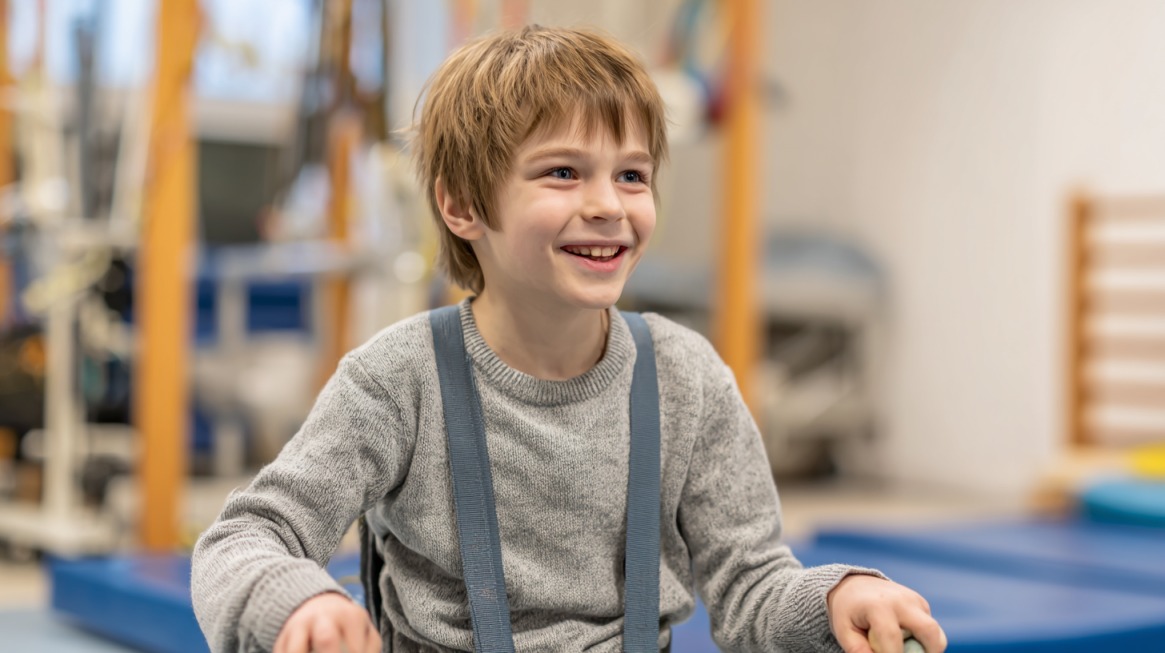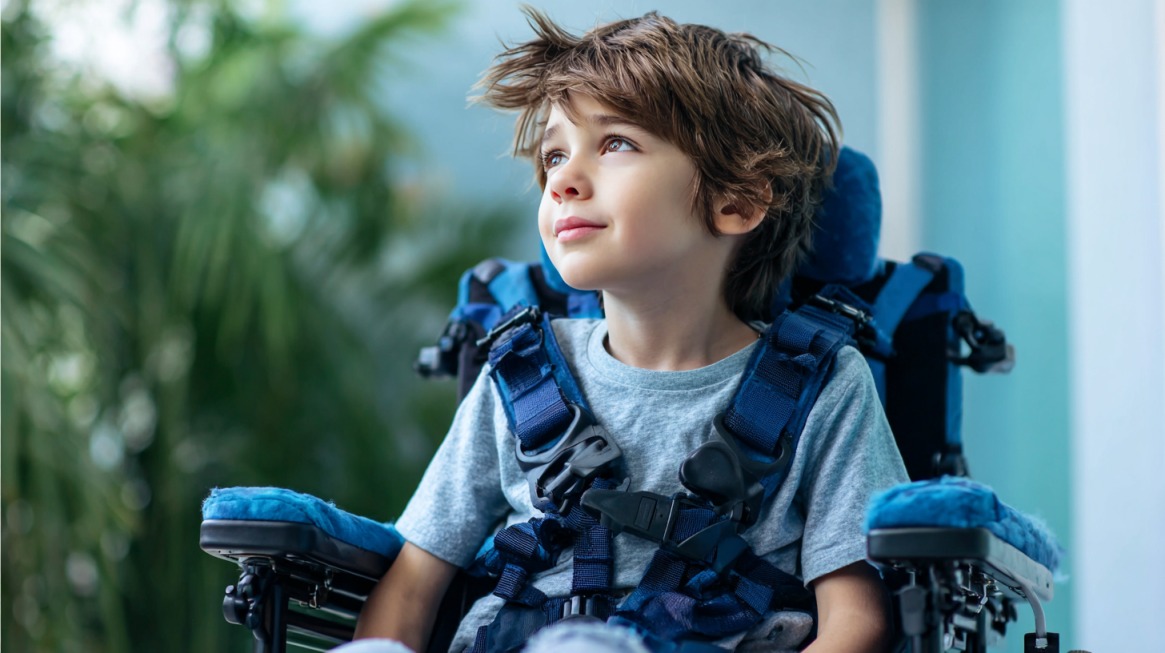Cerebral palsy (CP) refers to a group of neurological disorders that affect movement, muscle tone, and posture, caused by damage to the developing brain.
Dyskinetic Cerebral Palsy is one of the main subtypes and is marked by involuntary, fluctuating muscle movements that can range from slow and writhing to sudden and jerky.
Unlike spastic or ataxic types, dyskinetic CP primarily involves muscle control issues rather than stiffness or balance problems.
Affecting both children and adults, Dyskinetic Cerebral Palsy can significantly impact speech, mobility, and independence. Many individuals with this condition experience periods of normal muscle tone interrupted by uncontrolled motion, creating challenges in daily living.
Early diagnosis and continuous therapy are crucial for improving motor control, communication, and overall quality of life.
What Does Dyskinetic Cerebral Palsy Mean?

Dyskinetic Cerebral Palsy is a neurological condition that affects muscle control and coordination. It occurs due to damage in specific brain regions responsible for regulating voluntary movement, primarily the basal ganglia and, in some cases, the cerebellum.
When they are injured or underdeveloped, signals sent between the brain and muscles become irregular, causing involuntary or exaggerated motions.
Also known as Athetoid CP, Choreoathetoid CP, or Dystonic CP, this condition often results in unpredictable, fluctuating muscle tone. Individuals may appear relaxed one moment and experience sudden stiffness or jerking movements the next.
Such variability makes simple tasks like holding objects, sitting upright, or speaking clearly much more difficult.
Common types of involuntary movements include:
| Movement Type | Description | Effect on the Body |
|---|---|---|
| Athetosis | Slow, writhing motions that usually affect the hands, feet, arms, or face. | Continuous, fluid movements that make controlled gestures difficult. |
| Chorea | Rapid, dance-like movements flowing between muscle groups. | Jerky motions that intensify during emotional stress or excitement. |
| Dystonia | Repetitive, prolonged muscle contractions causing abnormal postures. | Twisting or contorting positions that worsen with voluntary movement. |
| Ballismus | Violent, flinging movements of the limbs, often on one side of the body. | Can severely disrupt balance and coordination. |
| Myoclonus | Sudden, brief muscle jerks involving one or several muscle groups. | Causes twitch-like motions that may interfere with precise actions. |
| Tremor | Rhythmic, oscillating movement of a body part, especially hands or head. | Becomes more noticeable during attempts at controlled movement. |
Two major subtypes define this condition: Choreoathetoid CP and Dystonic CP. Many people experience a combination of both, creating a complex pattern of movement disturbances. Some may even have overlapping features with spastic CP, which causes stiffness in certain muscles.
Daily life with Dyskinetic Cerebral Palsy can vary greatly. Movements may worsen when tired, anxious, or focused, while relaxation can bring temporary relief. Despite these motor difficulties, most individuals have normal intelligence.
The primary obstacle lies in expressing thoughts and emotions, as speech and fine motor control can be significantly affected.
Causes of Dyskinetic CP

Dyskinetic Cerebral Palsy develops when specific brain regions responsible for controlling movement and coordination, most notably the basal ganglia and cerebellum, are damaged or do not form correctly.
Damage to them disrupts the transmission of signals between the brain and muscles, resulting in uncontrolled or fluctuating movements.
The timing and cause of this brain injury determine how severely a person is affected. It can occur before birth (congenital), during birth, or after birth (acquired).
Before Birth (Congenital Causes)
A large percentage of cases originate before delivery, during fetal development. Factors that interfere with the baby’s oxygen or nutrient supply or cause inflammation in the developing brain are often responsible.
- Maternal infections such as cytomegalovirus, rubella, toxoplasmosis, or herpes can trigger brain inflammation or impair neural development.
- Fetal stroke may occur when blood flow to the developing brain is interrupted, leading to localized cell death in motor control regions.
- Severe jaundice in newborns can lead to kernicterus, a condition where excessive bilirubin damages brain cells.
- Genetic or metabolic disorders affecting brain chemistry and development may also increase vulnerability to dyskinetic forms of CP.

During Birth
Complications during delivery can place excessive stress on the baby’s brain and oxygen supply.
- Birth asphyxia occurs when oxygen deprivation leads to brain injury, often involving the basal ganglia.
- Prolonged or difficult labor can cause mechanical trauma or temporary restriction of blood flow.
- Birth trauma, including improper use of delivery tools or excessive pressure on the skull, can physically damage neural tissue.
After Birth (Acquired Causes)

In some cases, brain injury leading to Dyskinetic Cerebral Palsy occurs after birth.
- Infections such as meningitis or encephalitis can cause swelling and damage brain structures essential for motor control.
- Head injuries during early infancy may also lead to dyskinetic symptoms if the basal ganglia or cerebellum are affected.
- Untreated jaundice beyond the newborn period may allow bilirubin to accumulate, leading once again to kernicterus and permanent injury.
Signs & Symptoms
Symptoms of Dyskinetic Cerebral Palsy often become noticeable within the first two years of life, typically when developmental milestones such as sitting or walking are delayed.
Parents may notice that their child’s body movements seem irregular, exaggerated, or unpredictable.

Early Developmental Signs
Babies with Dyskinetic Cerebral Palsy might display difficulties in maintaining posture and controlling muscle tone.
- Poor head and trunk control, making it hard for infants to sit or balance.
- Delayed milestones, such as rolling over, crawling, or walking independently.
- Abnormal muscle tone, alternating between stiffness and floppiness.
- Feeding challenges, including difficulty sucking, swallowing, or controlling drool.
Because muscle tone fluctuates between tight and loose, children may appear clumsy or unable to maintain steady movements.
Tasks like reaching for objects or turning over can become laborious.
Associated Conditions
- Speech and communication difficulties result from poor control of the tongue and facial muscles.
- Vision and hearing issues, sometimes caused by associated neurological damage.
- Learning difficulties, though many children have normal intelligence but face barriers due to communication challenges.
- Occasional seizures, depending on the extent of brain involvement.
Children with this condition may appear cognitively aware but are often misunderstood because of speech and movement limitations.
A structured environment with reduced stress and tailored therapy sessions helps minimize involuntary motion and enhance motor control.
Diagnosis

Most diagnoses occur before the age of two, typically after parents or healthcare providers notice developmental delays or abnormal muscle movements.
Because symptoms can overlap with other neurological disorders, multiple tests and evaluations are needed to confirm the diagnosis.
- Physical examination: Physicians assess muscle tone, reflexes, and coordination to identify movement abnormalities.
- Imaging studies: MRI and CT scans reveal brain lesions or structural abnormalities, especially in the basal ganglia or cerebellum.
- EEG (Electroencephalogram): Used when seizures are suspected, helping detect irregular brain activity.
- Genetic and metabolic testing: Helps exclude inherited disorders that can mimic cerebral palsy symptoms.
- Developmental assessments: Evaluate motor skills, coordination, and fine motor control compared to age-appropriate milestones.
- Speech, hearing, and vision evaluations: Detect associated sensory impairments that often accompany Dyskinetic CP.
A multidisciplinary team, pediatric neurologists, physical therapists, and speech specialists, works together to confirm Dyskinetic Cerebral Palsy and establish an effective treatment plan.
Early detection allows therapies to begin when brain plasticity is highest, maximizing developmental progress.
Treatment & Therapies
There is currently no cure for Dyskinetic Cerebral Palsy, but early and consistent management can improve mobility, independence, and overall well-being.
Treatment plans focus on controlling symptoms, developing functional skills, and promoting adaptive independence.
| Category | Treatment | Purpose |
|---|---|---|
| Therapeutic Approaches | Physical therapy | Improves strength, posture, and movement control. |
| Occupational therapy | Builds daily living and adaptive skills. | |
| Speech therapy | Enhances speech, swallowing, and communication. | |
| Medications | Muscle relaxants (baclofen, diazepam) | Reduce stiffness and spasms. |
| Anticholinergics | Control involuntary movements. | |
| Botulinum toxin (Botox) | Relieves localized muscle tightness. | |
| Anti-seizure drugs | Manage seizure activity. | |
| Assistive Devices | Mobility aids (walkers, wheelchairs, braces) | Support mobility and posture. |
| Communication aids (AAC devices) | Help with speech and interaction. | |
| Surgical Options | Muscle or tendon release | Eases tightness and corrects alignment. |
| Selective dorsal rhizotomy | Reduces abnormal muscle tone. | |
| Emerging Treatments | Deep brain stimulation (DBS) | Reduces dystonic and athetoid movements. |
| Stem cell therapy | Aims to repair damaged brain cells. |
The Bottom Line
Early diagnosis and consistent intervention play a key role in managing Dyskinetic Cerebral Palsy. Progress in medical research continues to offer new hope for improving movement control and independence.
With multidisciplinary collaboration among healthcare providers, families, and therapists, individuals can develop adaptive strategies that enhance mobility, communication, and confidence.
Each case is distinct, and personalized care remains essential for promoting a fulfilling life with Dyskinetic Cerebral Palsy.

